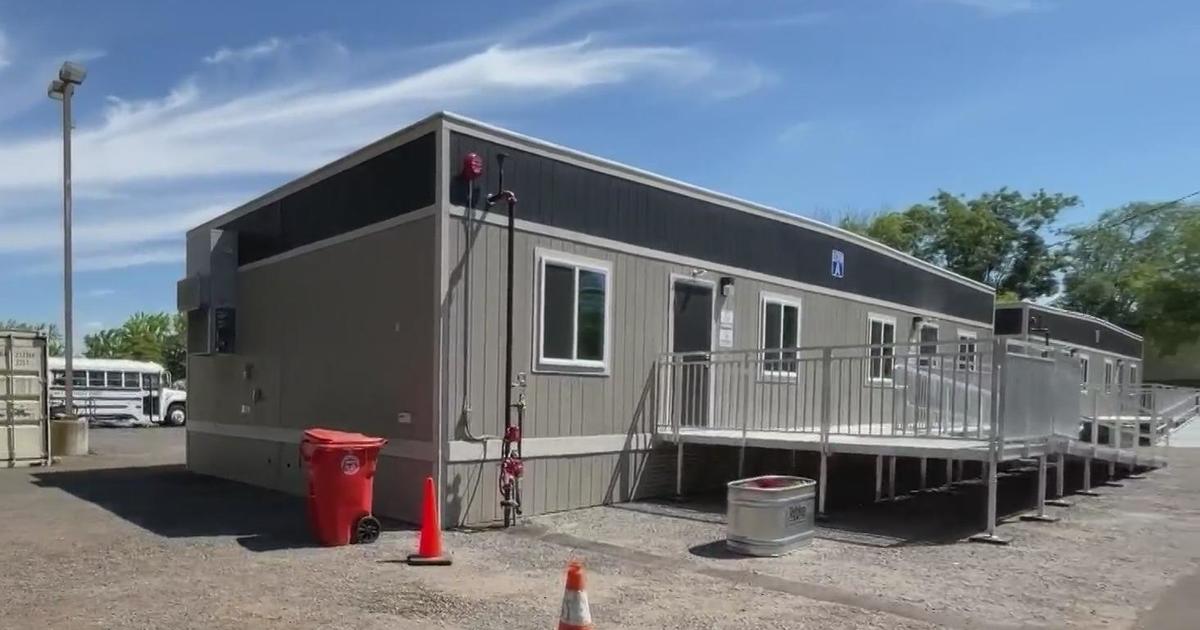Call Kurtis: My Air Bag Is Off!
SACRAMENTO (CBS13) - It's a federal requirement that all new passenger cars have frontal air bags. When a Placerville woman noticed her air bag was off in her new truck, she called Kurtis Ming.
"I am 5'3" with my boots on and approximately 103 pounds," says Ames Duncan.
She may be small, but when she sits in the passenger seat of her 2011 Nissan Frontier she doesn't think the air bag should deactivate.
"I'm not a child. I'm an adult. I need an air bag!"
And she doesn't like what she's been told.
"Two of the suggestions they gave me; gain some weight and don't ever be a passenger in the truck. Thanks," says Ames.
Initially she says her dealership was concerned.
"'You need to leave the truck with us because it's a major safety issue and we need to take care of it for you,'" Ames recalls the workers at the dealership telling her.
She says they replaced part of her seat but that didn't work. The "air bag off" light still illuminates.
Now Ames rides in fear, "That I'm going to get in an accident and I'm going to get killed because I don't have an air bag."
Nissan confirmed to us Ames' truck is "... most likely classifying her as a child ... based on her stature and weight distribution..." Nissan also tells us, "... the system … is working as designed by turning the air bag off to help reduce the risk of inflation injury."
The National Highway Traffic Safety Administration says on its website some advanced air bag systems are designed to turn a frontal air bag off for kids or small adults. But is Ames safer with or without the air bag? The feds failed to answer that question.
We thought we'd see how much additional weight it would take to activate Ames' air bag for her height. We give Ames a 25-pound weight to put on her lap. The air bag off light is still illuminated, so we hand her five more pounds. That turns the light off, meaning her air bag is activated.
"So I have to drive around with 30 pounds in my lap to have an air bag?" Ames asks.
"When it comes to you and this truck, what are you thinking? What are you going to do with this truck?" asks Kurtis.
"Live with it, I guess. And hope that I never get in an accident," says Ames.
Ames asked the NHTSA if she could get her air bag mechanically turned on. She was told no.
Statement from Nissan:
The 2011 Frontier is equipped with the Nissan Advanced Air Bag System (AABS), which is designed to meet certification requirements under U.S. Federal Motor Vehicle Safety Standard 208 (FMVSS 208). The purpose of this standard is, among other things, to help reduce the risk of injury from an inflating air bag to certain front passenger seat occupants, such as children, by requiring the air bag to be automatically turned off.
To accomplish this, the AABS includes an occupant classification sensor, which is essentially a pressure sensor. The sensor is mounted in the front passenger seat cushion, and is designed to detect an occupant or object on the seat by the weight applied to it. In addition, the AABS includes a front passenger seat belt tension sensor, which is designed to detect belt tension resulting from a locked seat belt when installing a child restraint.
Based on inputs from these sensors, the front passenger air bag is automatically turned off under the following conditions:
1) When the front passenger seat is empty.
2) When the front passenger seat is occupied by a small adult, child, or child restraint.
Front passenger seat adult occupants who are properly seated and using the seat belt will typically not cause the passenger air bag to be turned off. However, for smaller adults it may be turned off if the occupant takes his or her weight off the seat cushion (for example, by not sitting upright, by sitting on an edge of the seat, or by otherwise being out of position). If this customer is properly seated and the air bag is still turned off, the AABS is most likely classifying her as a child. This can happen for certain small adults depending on their stature and body weight distribution and the system in this case is working as designed by turning the air bag off to help reduce the risk of inflation injury.
Research has shown that a properly worn seat belt provides the most effective protection in the event of a crash, and Nissan encourages all occupants to buckle up every time they are driving or riding in a vehicle. Air bags are a supplemental restraint system.
The issue observed by this customer is not a defect. As explained above, the AABS is designed to turn the passenger air bag off under certain conditions, as required by regulation. While the regulatory requirements are the same for all vehicles, different Nissan models use different types of occupant classification systems that use other type of sensors, so it is possible that this customer may experience a different result when sitting in the front passenger seat of a different vehicle.
There is no specified weight threshold. The weight detected by the pressure sensor can vary based on how an occupant is seated or whether a child restraint is cinched down in the seat. Weight is only one of the variables used when classifying an occupant or object in the front passenger seat. Federal regulations require a variety of seat occupancy conditions to be evaluated, including different size occupants and child restraints, and the occupant classification system in the 2011 Frontier is tested against all these requirements.
Statement from NHTSA:
Federal Motor Vehicle Safety Standard (FMVSS) No. 208, "Occupant crash protection," requires light passenger vehicles to have frontal air bags for the protection of occupants in frontal crashes. These air bags have been highly effective in reducing serious injuries and fatalities from frontal crashes. We estimate these systems have saved 30,232 lives from 1987 through the end of 2009.
However, during the 1990s, NHTSA had confirmed over 100 crashes in which an air bag deployment had caused a fatal injury. Most of those fatalities were to children and small adult women. Consequently, as part of the Reauthorization Act of 1998, Congress directed NHTSA to issue "a notice of proposed rulemaking to improve occupant protection for occupants of different sizes, belted and unbelted, under FMVSS No. 208, while minimizing the risk to infants, children, and other occupants from injuries and deaths caused by air bags, by means that include advanced air bags."
In May of 2000, we published a final rule for FMVSS No. 208 in response to this directive. The advanced air requirements, which include some amendments since that time, include a high speed crash test requirement incorporating a 5th percentile adult female test dummy to ensure a minimum level of frontal occupant crash protection, and several low risk deployment and out-of-position tests using a range of dummy sizes. We also incorporated the 5th percentile adult female test dummy into our model year 2011 New Car Assessment Program, for the passenger side.
FMVSS No. 208 allows vehicle manufacturers to comply with the advanced air bag requirements in several ways. One option requires (through specified test requirements) that the air bag must deactivate when there is a 6-year-old child dummy weighing 52 pounds in the right front passenger seat, and activate when a 5th percentile adult female dummy weighing 108 pounds is in the seat. Based upon their risk assessment of a particular design, the manufacturer establishes the threshold between these two weights at which the air bag is activated. Factors such as vehicle structural stiffness, air bag deployment characteristics, and air bag inflator properties are some of the considerations manufacturers take into account in establishing this threshold. For a vehicle where the passenger seat air bag is off for an occupant weighing 103 pounds, it would appear that the occupant is just under the air bag activation threshold that the manufacturer has selected for this particular make and model.
As part of our efforts in the 1990's to preserve the benefits of air bags, while also providing a means for reducing the risk of serious or fatal injury that air bags posed to certain identifiable groups of people (e.g., people who cannot avoid sitting extremely close to air bags, people with certain medical conditions, and young children), we also issued a rule permitting businesses to install retrofit on-off switches for air bags in specified circumstances. In order to obtain an on-off switch, vehicle owners must, among other things, certify that they or another user of their vehicle is a member of one of the risk groups identified in the rule. The identified risk groups were developed at a NHTSA-sponsored physicians' conference on medical conditions that warrant turning off an air bag. These switches are not capable of activating an air bag suppressed by an advanced air bag suppression system.
We have not issued a rule to permit businesses to override the safety devices selected by vehicle manufacturers pursuant to the statutorily mandated rulemaking to minimize the risk to infants, children, and other occupants from injuries and deaths caused by air bags.
NHTSA provides detailed information to consumers about air bag safety at http://www.safercar.gov/Air+Bags The information emphasizes that air bags are supplemental safety devices, and occupants should always wear their seat belts. It also emphasizes that all children under 13 should be placed in the rear seat, and that the rear seat is the safest location for children.
The agency estimates that the effectiveness of lap/shoulder belts for adults (including a 103 pound adult) is 45% compared to an unrestrained front seated adult. Thus, 45 occupants for every 100 potential fatalities would survive because of using lap/shoulder belts. The effectiveness for air bags with lap/shoulder belts for adults (including a 103 pound adult) is 50%. Thus, by not having an air bag, the chance of being saved by the restraints used decreases from 50 percent to 45 percent.



